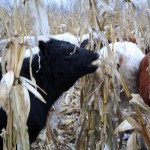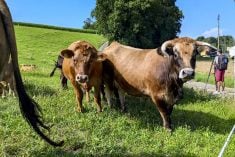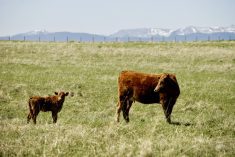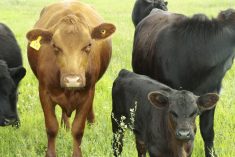Bruce and Valve Forrest are constantly innovating on their beef farming operation. They have been direct marketing local beef years before local beef became a fad. They have bypassed owning a bull, using artificial insemination to get their cows pregnant, plus introduce top genetics into their herd.
Recently, another focus has been reducing feed costs. For the last few years, corn has been a big part of their nutrition package. Not grain corn, but standing corn, grazed to extend the cows’ days on pasture, and reduce the amount of stored feed required to feed the cows.
Bruce and Valve run a 40 head cow calf to finish operation. During the time period observed, 39 cow-calf pairs, and six replacement heifers grazed the corn. The calves were born in April, and would be 6-9 months old in the trial.
For the 2012 corn grazing season, Bruce kept complete records of the days grazing, and supplemental feed required to keep his cows out in the field until just before Christmas. Ordinarily by mid-September the cows would be getting stored forages. From September 16 to December 15, the cow calf pairs and replacement heifers grazed corn instead. The cows were strip grazed, and moved daily to a new section of corn.
Moving fence can be tricky with cows looking to surge past you into a new section. Bruce supplemented the cows and calves daily during fence moving time to distract the animals. The cows received 2 lbs per day of a screening pellet, and the calves 3 lbs per day of a creep ration. While they were eating this, Bruce would move his fence forward. The beefers also had access to a bale of dry hay daily, to make sure they always had gut fill.
Read Also

What to know before you go to Agribition 2025
If you’re attending Agribition 2025, this is the place to find out about tickets, dates and what’s happening this year.
Labour to move the fence daily, plus provide supplemental feed was one hour. This cost was not added to the direct cost total.
What were some of the direct benefits that the Forrests observed? The cows were very healthy, with lots of exercise in going out to the corn daily. Manure was spread over the ground on a consistent basis, not piled up to be spread at a later date. The cattle gained weight. Over the 90 days, the cows gained about 1 lb. per day. The calves performed very well, averaging 2.4 lbs. per day weight gain. But were there any significant savings?
The Forrests used their own equipment to prepare the ground and plant the corn. The ground was disked twice, nitrogen spread, and the corn was planted using their own seed drill. Roundup was used for weed control. All in, the corn cost $193.59 per acre to grow. Total costs, including the supplemental feed and hay amounted to $8,635.
Planting corn resulted in 90 extra grazing days for 39 cows, 39 calves, and 6 bred heifers. This amounted to 7,560 animal grazing days at a total cost of $1.14/head/day, well below the alternative cost of feeding stored hay to the animals in a confined area. The number of grazing days per acre was 343.
Performance did not suffer, the animals were healthy, and costs were lower. As Bruce sees it, there is a lot of winning attributes to extending the grazing season with corn.
The Forrest results echo similar trials at the Western Beef Development Centre in Saskatchewan in 2011. Those results are in Table 2.
Tips for grazing corn
- Use an electric fence. If the cattle are trained to respect the current in electric fencing, one strand is usually sufficient to contain livestock. Make sure to spend the time to train the cattle to respect electric fence prior to turnout in the corn.
- Make sure the ground is dry or frozen before turning the herd into the field. If the ground is wet, cows will get dirty, plugging can occur, and corn stalks get pushed into the mud and not eaten.
- Sample your corn plant. Chop up some whole corn stalks, making a representative feed sample. Send it away for a feed test. Cows need energy, which the corn plants will have. Calves may need some protein supplementation.
- Review your mineral supplementation. Corn is lower in calcium than a legume based hay. You may need to use a higher calcium to phosphorus mineral to balance the ratio. Providing some legume based hay can also give the animals calcium. Feeding hay will also increase the amount of rumen degradable protein, allowing the rumen to make better use of the corn stalk as an energy source.
- Limiting the access to cows to the standing corn is important. Cows can overload on grain if they can free choice pick and choose between corn cobs and stalk. Make sure and check the cows and calves to make sure they are not getting too much grain. Watch their feces. If the manure is too runny, they may be getting too much grain.
- Force the cows to clean up as much residue as possible. An article from Manitoba recommends no more than 2000 kg/ha of residue left behind.
- Have a backup feeding strategy in case of bad weather or excess snow.
For more information: call 1-877-424-1300 or email [email protected].
Barry Potter is an agriculture development advisor with the Ontario Ministry of Agriculture and Food (OMAF).



















